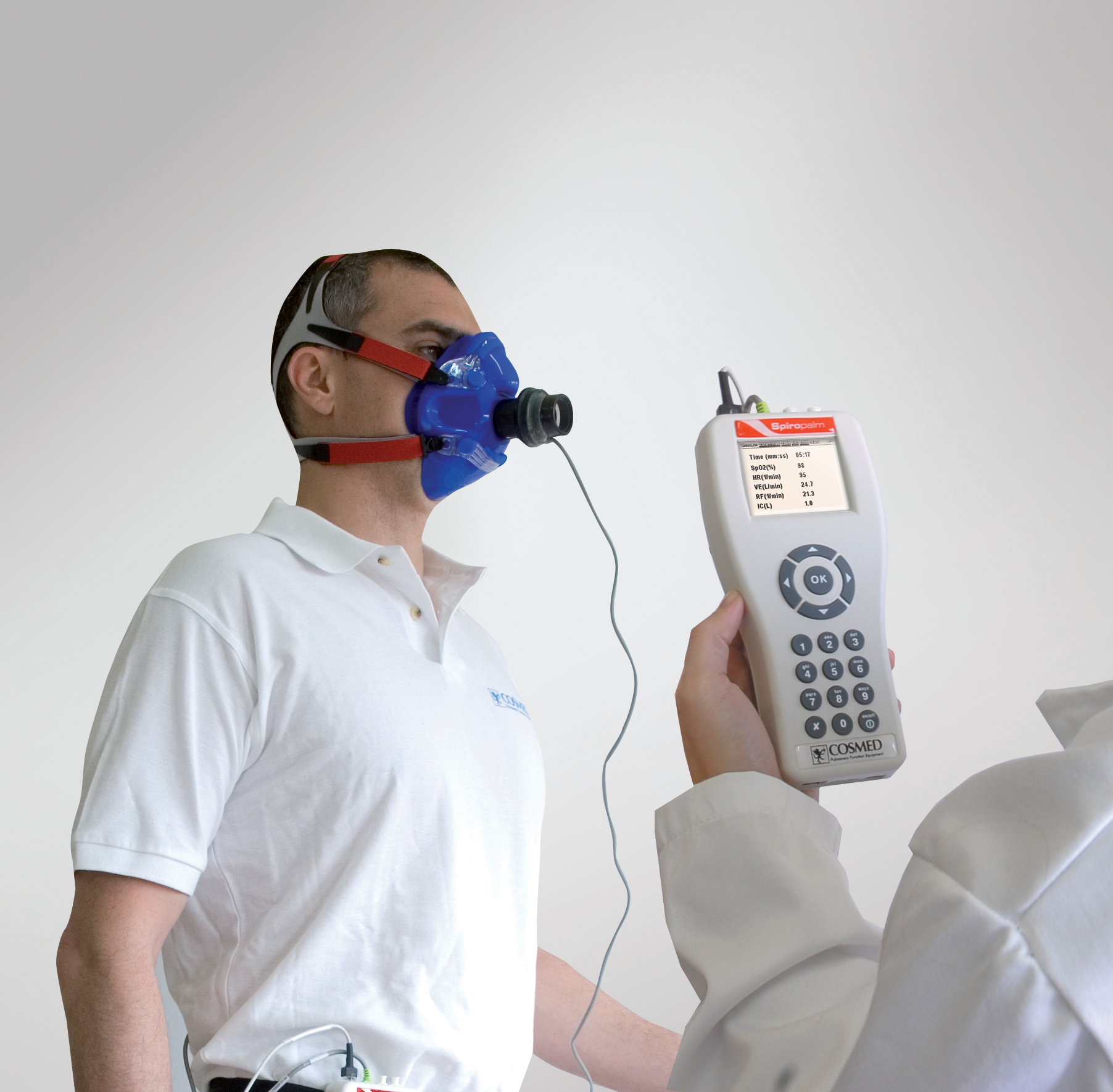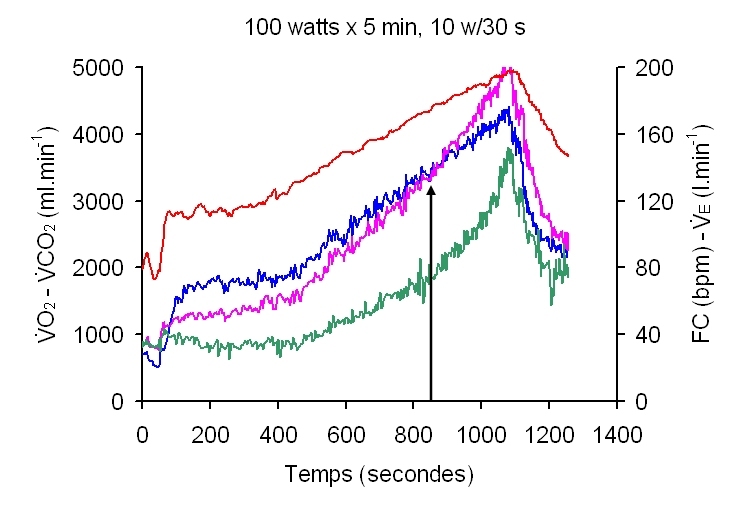
Exercise tests are an effective way to not only measure physical strength and endurance, but also how well you can breathe. They can reveal vital information about your lung function, your oxygen levels, and your general physical abilities.
This can help you and any health professionals you work with better understand and treat your disease. Because of this, both doctors and fitness specialists use a variety of different exercise tests to evaluate people with COPD and other lung conditions.
Why Take an Exercise Test?
If you have COPD, your doctor might ask you to take an exercise test for a several possible reasons, including to measure how severe your symptoms are, what kind of exercise you can tolerate, and to determine what kinds of treatments can help. They are also useful for monitoring general lung function and tracking improvements or decline in your ability to exercise over time.
Exercise test results also serve as a good measure of how your disease and respiratory symptoms affect your mobility and your everyday life on a practical level. Because of this, they are especially useful for evaluating people with advanced COPD, who often suffer from shortness of breath so severe that normal daily activities become a struggle.
There are many different types of exercise tests, each designed to measure your physical and respiratory abilities in a different way. The results can be used for a variety of different purposes, including to measure COPD symptoms, to design personalized exercise programs, and to determine whether or not a patient needs supplemental oxygen therapy.
That's why, in this post, we're going to introduce you to the five most common exercise tests that medical and fitness specialists use to evaluate COPD and other respiratory diseases. We'll explain what these tests are, how they work, and what each test can tell you about your health.
With this knowledge, you'll know what to expect and how to prepare the next time your doctor wants you to complete an exercise test. Most importantly, however, this will also give you the vocabulary and the information you need to actually read your test results and understand what they mean for you.
Field Walking Tests Versus Laboratory Tests
There are two main categories of exercise tests: field walking tests and laboratory tests. Laboratory tests are usually done on a treadmill or exercise bike in a lab, while field walking tests are performed on flat ground, usually in a large, open space.
Lab exercise tests tend to be more intense because the exercise machine sets the pace and pushes you to keep moving continuously. This makes it more difficult to pause, slow down, or stop for a rest during the test.
During most field walking tests, however, you can set your own pace, pause, and take breaks as often as you need to. That's why, in many cases, field walking tests are better suited for people with chronic respiratory diseases, who often have serious physical limitations and low exercise tolerance.
Laboratory exercise tests can also get pricey because they require an exercise machine and other specialized equipment (e.g. electrocardiogram sensors). On the other hand, field walking tests can be done with minimal equipment, making them a simpler and less expensive choice.
In this post, we are going to focus mainly on field walking tests, since they are the simplest and most common types of exercise tests used for people with COPD. However, we will also discuss one lab-based test, the cardio-pulmonary exercise test, which many researchers consider the most accurate and reliable form of exercise testing.
We'll go over each test in detail so you'll know what to expect from an exercise test and how to interpret your results. We've also included some extra tips at the end of this article to help you prepare for your exercise test.
The following sections include: the 6-minute walk test, the incremental shuttle walk test, the endurance shuttle walk test, the sit-to-stand test, and the cardio-pulmonary exercise test.
The 6-Minute Walk Test

The 6-minute walk test (abbreviated 6MWT) is a simple test that measures how far you can walk in 6 minutes. This is one of the most frequent types of exercise tests used for people with COPD and other respiratory conditions.
The results give you a general idea of how well your lungs function and how much physical endurance you have. This can be used to determine how much your disease affects your ability to get around and help your doctor determine the best course of treatment.
6-minute walk tests are often done multiple times for comparison, especially before starting a new COPD medication or another type of therapy. In that case, you will take one test before beginning the treatment and another shortly after in order to see if your test results change.
How the 6-minute Walk Test Works
To complete this 6-minute walk test, you will simply walk on hard, even ground for exactly 6-minutes straight. The goal is to measure how much distance you can cover in that time without pushing yourself too hard.
Before the test, you will sit and rest for about ten minutes so the test technician can get a baseline measure of your heart rate, blood pressure, and blood oxygen saturation. Then, the technician will ask you to rate your breathlessness via a standard scale, such as the Borg scale.
The Borg scale allows you to choose from a range of numbers, one to ten, with higher numbers representing more severe shortness of breath. To use it, you simply match the symptoms you feel with the number that best describes them on the scale.
This helps you quantify your breathlessness in a consistent way that you and your doctor can use to measure changes over time. Breathlessness scales are used all the time in COPD evaluations, including regular check-ups and other types of exercise tests.
After taking down your breathlessness rating, the technician will start a stopwatch timer and have you begin walking on the track. To complete the test, all you have to do is continue walking until the timer reaches six minutes.
You should try to walk as far as you can, but you may pause for breath or stop walking any time you need to. However, the timer will keep running and any rests you take will affect your test results.
During the test you may also use supplemental oxygen, if you're prescribed it, and any walking aids (such as a cane or walker) that you normally use to get around. Just make sure to bring the same aids for future exercise tests so your results will be consistent.
Let the technician know if you feel too exhausted to finish or experience any severe or dangerous symptoms. Intolerable shortness of breath, chest pain, and leg pain are all urgent indications that you should stop the test.
When you make it to the six minute mark, the walking part of the test will be over and you can sit down to rest. The technician will record the total number of laps you completed, ask you to rate your breathlessness again, and record your heart rate, blood pressure, and blood oxygen saturation once more.
What the Results of Your 6-Minute Walk Test Mean
The results of the 6-minute walk test reflect your general respiratory health and give you a baseline measure of your physical ability. The primary result of the test is your 6-minute walk distance (abbreviated 6MWD).
Interpreting Your 6-minute Walk Distance Score
A longer 6MWD indicates better exercise tolerance and better lung function, while shorter distances indicate poorer exercise tolerance and lung function decline. Research shows that you need to increase your distance by about thirty meters (about 98 feet) in order to determine that you've made a significant improvement.
You can also compare your 6-minute walk distance to standard reference values in order to see how your results compare to healthy people of your age, sex, weight, and height. Your doctor may provide you with a table of reference values, or you can plug your 6MWD into this online calculator.
Since walking is a light and simple activity that's part of normal living, the 6-minute walk distance is considered an excellent measure of how much your disease affects your everyday life. Studies show that short distances (especially distances less than 150 meters) are associated with more severe respiratory disease, more severe mobility limitations, and a higher risk of death.
Interpreting Your Breathlessness Scores
Your breathlessness scores are also important, because they specifically measure how severe your COPD symptoms are and how they change in response to light physical activity. If there is little change in your breathlessness score throughout the test, this indicates that you tolerate exercise relatively well.
On the other hand, a significant increase in breathlessness indicates that light physical activity puts a lot of strain on your lungs. This is a sign of low exercise tolerance and more advanced COPD.
Interpreting Your Heart Rate Measurements

In general, the lower your resting heart rate is, the better your cardiovascular fitness. That's because your heart rate is a good indication of how hard your heart has to strain in order to do it's job.
A lower heart rate means that your heart can pump your blood effectively with fewer beats. This usually indicates better exercise tolerance and better physical endurance.
A faster heart rate means that your heart has to work harder in order to pump enough blood around your body to meet your body's needs. This indicates low cardiovascular fitness and lower exercise tolerance.
A fast resting heart rate can also be a sign of other health conditions, including high blood pressure and narrowed arteries caused by cardiovascular disease. It can also indicate that your blood oxygen levels are low, which can be caused by poor lung function.
Low blood oxygen levels force your heart to pump blood faster, which often resulting in a higher resting heart rate. As a result, your heart rate and blood oxygen saturation readings can help your doctor determine how well your lungs are working.
Studies even show that resting heart rate can reliably predict the severity of a person's COPD. Higher resting heart rates are associated with more advanced COPD and a higher risk of death from the disease.
Interpreting Your Oxygen Saturation Reading
Another important measure is your blood oxygen saturation readings, which are usually recorded before, after, and sometimes during the test. This number is usually written as your SpO2%, and it can tell you if, and to what degree, basic exercise causes your oxygen levels to drop.
When your blood oxygen saturation falls to low—below 95%--it is known as hypoxemia, a potentially dangerous condition that requires treatment (often with supplemental oxygen therapy) to correct. This happens when your lungs can't absorb enough oxygen to supply your body with the full amount that it needs.
Some people with COPD experience chronic hypoxemia, meaning their blood oxygen levels tend to be too low most of the time. Hypoxemia tends to get more severe as COPD progresses, and the severity of hypoxemia is a good indication of how advanced your COPD is.
Blood oxygen saturation readings are also the main determining factor when deciding whether or not someone needs to use supplemental oxygen. In most cases, people with COPD and other chronic respiratory diseases begin supplemental oxygen therapy when their oxygen levels fall below about 90%.
However, some people with COPD only experience low blood oxygen saturation when they exercise, a condition commonly referred to as exercise-induced oxygen de-saturation. This can be difficult to catch during normal check-ups and exams, since it only occurs during physical activity.
Because of this, exercise tests like the 6-minute walk test (and especially the incremental shuttle walk test, which we'll discuss next) are useful for catching exercise-induced hypoxemia in people with respiratory diseases. By recording your oxygen saturation levels at different points during the test, it can reveal whether or not exercise causes them to drop.
Putting it All Together

All of this information helps your doctor determine how severe your symptoms are and make a more accurate prognosis for your disease. For instance, a variety of studies have shown that, in general, lower 6MWT scores in people with COPD are associated with a higher risk for hospitalization or death.
This isn't surprising, since studies have long shown that physical activity and exercise are vital for maintaining health, breathing efficiency, and physical mobility in people with COPD. Because of this, exercise capacity is generally a pretty good predictor of how advanced the disease is and what kinds of outcomes you can expect.
In many cases, however, the primary purpose of the 6-minute walk test is to establish a baseline to compare future 6MWT results against. Then, repeat tests will reveal how your endurance, which is representative of your overall lung function, improves or declines over time.
The Incremental Shuttle Walk Test
The incremental shuttle walk test (abbreviated ISWT) is another walking exercise used to measure both lung function and physical endurance. However, the ISWT is slightly more challenging than the 6-minute walk test because it pushes you to walk more quickly and for a longer period of time.
The goal of the ISWT is to see how many times you can walk up and down a short track while steadily increasing your speed. You'll be supervised by a technician who will record basic data about your heart rate, oxygen levels, and breathing symptoms at regular intervals during the test.
The goal of the test is to measure your lung function as you progressively work up to your maximum exercise capacity. This gives you a solid measure of your endurance and how your oxygen levels change as you increase your exercise intensity.
Like the 6-minute walk test, you may need to take the ISWT on more than one occasion in order to see if the results change. This is particularly useful for measuring whether or not a new medication, exercise program, or other treatment is helping you or not.
How the Incremental Shuttle Walk Test Works

To take an incremental shuttle walk test, you will walk on a course made up of two cones placed about thirty feet apart on hard, flat ground. The full path you walk from cone to cone is exactly ten meters (or about 32 feet) in length.
Each time you complete a trip from one cone to another, you've finished a single increment, or shuttle. When you take the test, you will complete multiple shuttles one after the other at gradually increasing speeds.
Before the test, your doctor will tell you when and if you should use your bronchodilator and other medications on the testing day. To be safe, you should always bring your bronchodilator medication, your supplemental oxygen (if you use it), and any walking aids you normally use.
In order to keep the test consistent, incremental shuttle walk tests are always led by a tape of recorded audio instructions. Although you will have a test technician to help you, the recording will be your main source of instruction throughout the test; it will tell you exactly when to start and set your walking pace.
As you walk, the recording will play tones (or beeps) in a steady rhythm to match the beat of your steps. To complete each shuttle, you will walk in time with recording, taking one step each time you hear a beep.
The tones will play slowly at first but speed up slightly every minute, forcing you to increase your walking pace gradually throughout the test. The recording is also timed so that you have to complete each full shuttle in a specific amount of time before an end tone plays.
As you walk, the technician running your test will record several physical measures at regular intervals, including your heart rate (in beats per minute), your blood oxygen saturation (written as SpO2 %), and what degree of breathlessness you experience. You may stop the test at any time if it becomes too difficult to breathe or if you get too exhausted to continue.
The incremental shuttle walking test ends when you can no longer go on or when you can no longer keep up with the pace set by the recording. Once you finish, the technician will immediately record your blood oxygen saturation, heart rate, and breathing symptoms again.
Then, after you've had two minutes to rest, the technician will take all these measurements one final time. He will also record the final number of shuttles you walked and your reason for stopping the test.
Check out this video to see an example of how an actual incremental shuttle walk test is performed.
What the Results of Your Incremental Shuttle Walk Test Mean
At the end of your incremental shuttle walk test, the results will show your SpO2, heart rate, and breathlessness at each minute during the test. It will also state why you had to stop the test and the total number of shuttles you were able to complete.
These are important measures that can tell you a variety of things about your physical fitness and your overall respiratory health. Some of these measures are very similar to the ones taken during the 6-minute walk test, so we will go over them only briefly again here.
Interpreting Your Blood Oxygen Saturation Scores

As we discussed earlier in this post, your blood oxygen concentration, or SpO2, tells you how much oxygen is in your blood. This indicates how well your lungs are functioning; an SpO2 above 95% is considered normal, while anything less indicates that you have hypoxemia.
One of the most important things an incremental shuttle walk test can reveal is how your blood oxygen saturation changes throughout the course of the test. This can reveal whether or not you experience exercise-induced hypoxemia and help your doctor determine the best way to treat it.
Compared to the 6-minute walk test, the ISWT is generally more intense, so it allows you to see how your oxygen saturation levels respond to heavier amounts of exercise. It also gives you a wider range of data points to analyze, since it measures your oxygen levels at regular intervals from rest all the way up to your maximum pace.
Interpreting Your Breathlessness Scores
You can interpret your ISWT breathlessness scores in much the same way that you would for a 6-minute walk test. The more your breathlessness increases throughout the test, the more severe your respiratory symptoms and your exercise tolerance are.
On the other hand, a smaller change in breathlessness indicates relatively better tolerance and less severe respiratory symptoms. By comparing your breathlessness scores between multiple tests, you can tell if your symptoms and tolerance have declined, improved, or stayed the same.
Interpreting Your Heart Rate Scores
You can interpret your heart rate scores as a simple measure of your overall cardiovascular fitness just like you can for the 6-minute walk test. A faster heart rate is a sign of low physical fitness and reduced exercise tolerance, while a slower heart-rate indicates better physical fitness and better physical endurance.
However, your heart rate scores can reveal even more detail about your lungs and your cardiovascular health when considered in combination with other physical health data collected during the test. Your doctor can use these relationships between heart rate and other measures to make more specific judgments about your lung health and how to treat your disease.
Additionally, by monitoring your heart rate while you exercise, the ISWT tells you how much strain that the exercise puts on your heart. Your heart rate serves as an excellent measure of how much you are exerting yourself, which can tell you how difficult and intense the exercise is for you.
It can also help you and your test technician ensure you don't push yourself too hard during the test. If your heart rate rises so high that it reaches an unsafe level (e.g. too far above your maximum heart rate for too long), you will know that it's time to slow down or stop the test.
Interpreting Your Shuttle Results

The primary result from an incremental shuttle walk test is the total number of shuttles you were able to complete before having to stop the test. Your doctor or exercise specialist can use these results to determine your general fitness level and what kind of exercises you can tolerate.
This is particularly useful for people with COPD and other respiratory diseases, who often need help learning how to exercise with the physical limitations and symptoms caused by their disease. The shuttle test results can help define those limitations and make it easier to create fitness program tailored to your needs.
If you've taken the ISWT before, you can also compare your most recent total distance to your last test results to see if you've made any measurable improvements. In general, it is considered a “slight improvement” if you can increase your ISWT walking distance by about 47 meters (or about 155 feet).
Endurance Shuttle Walk Test
The endurance shuttle walk test (abbreviated ESWT) is nearly identical to the interval shuttle walk test and you complete it in almost exactly the same way. The main difference is that, instead of using the ISWT audio recording, you'll follow a specially-chosen recording that's based on your ISWT results.
This recording will set a different pace, one that is adjusted to match your personal physically abilities. More precisely, the pace of the test is based on a percentage of your maximum ISWT scores.
Your results will also set a baseline that you can compare to previous ISWT results and future ESWT results. This can tell you whether your lung function is improving or declining, and give you an idea of how effective new exercise and treatment plans have been.
The Sit-to-Stand Test
This is an extremely quick and simple test that measures how quickly you can stand up and sit down repeatedly. This exercise is meant to simulate a short burst of exercise and it's used mainly to measure your overall exercise capacity.
This is useful for people with COPD who need to be evaluated for an exercise program like pulmonary rehabilitation. The results can help specialists determine what kinds of exercises and intensity levels you can tolerate, and what kind of training you could benefit from the most.
The sit-to-stand test also gives you a general measure of how serious your lung disease is, since your performance on the test is representative of your general respiratory health. This helps your doctor better understand your disease and how it affects your ability to exercise.
How the Sit-to-Sand Test Works
There are several different ways to perform the sit-to-stand test, but they all follow the same basic formula: first, you begin by sitting on a special chair with a seat that's exactly 48 centimeters from the ground. Then, you cross your arms over your chest, wait for the technician's signal, and begin standing up and sitting down as fast as you can.
Depending on the test design, you may be asked to stand and sit repeatedly for a set length of time. In other cases, you will need to stand and sit a specific number of times (called repetitions) before completing the test.
The most common sit-to-stand tests use 30-second timers, 1-minute timers, or a series of 5 sit-to-stand repetitions. The shorter tests—the 30-second test and 5-repetition test—are often best suited for people with severe physical limitations, including people with advanced COPD.
Before you start, your test technician will explain which length of test they are using and tell you exactly what to do. When it's time to start, the technician will signal you to go and start the timer at the same moment that you begin standing up for the first time.
The technician will stop the timer as soon as your time is up or after you've finished standing up for final repetition. Then, he will record your final result: the total number of repetitions you completed, or the time it took you to finish the required number of repetitions.
What the Results of Your Sit-to-Stand Test Mean

Sit-to-stand tests are primarily used to determine your relative exercise capacity, which reflects your muscle strength and the severity of your respiratory symptoms. This is an important measure often used for fitness training, but your doctor can also use it to predict the severity of your COPD and what kinds of complications you may be at risk for.
Sit-to-stand tests, like other exercise tests, are often done repeatedly to check for improvements or declines in fitness over time. They are especially useful for tracking progress and determining how effective a new exercise plan or treatment is.
It's a sign of improvement if future test results show that you can sit-to-stand more quickly than before, or complete more sit-to-stand repetitions within the given time limit. More specifically, studies show that an increase of three repetitions during the 1-minute sit-to-stand test is the minimum amount required to be considered a meaningful improvement.
Cardio-Pulmonary Exercise Test
Cardiopulmonary exercise tests (sometimes called cardiac stress tests or simply exercise stress tests) are different from the exercise tests we've discussed so far in this post. The main difference is that cardio-pulmonary exercise tests are lab tests, rather than field tests, which means they require a treadmill or exercise bike to complete.
Because cardiopulmonary exercise tests are done in a controlled lab setting, they can collect a lot of detailed data about your heart, respiration, and cardiovascular fitness that most field tests cannot measure. This makes them more accurate, but also more pricey and difficult to arrange.
Cardiopulmonary exercise tests are also more strenuous in general than most field walking tests. Because of this, field walking tests are often preferred for people with serious respiratory diseases that affect their ability to breathe.
However, many people with mild COPD or lesser breathing symptoms can still tolerate taking a cardio-pulmonary exercise test. Which type of test your doctor recommends will depend on your individual physical condition and the type of data your doctor wants to see.
Cardiopulmonary tests are often used to evaluate people with cardiovascular diseases as well as respiratory conditions. Tests conducted for cardiovascular reasons generally focus on monitoring your heart rhythm while you exercise, while tests conducted for pulmonary reasons put more emphasis on monitoring your oxygen levels and breathing.
How the Cardiopulmonary Exercise Test Works

The cardiopulmonary exercise test is an endurance test meant to measure your maximum physical abilities. The entire test is conducted on a treadmill (or sometimes an exercise bike) which is programmed to set the pace during the test.
You will also need to have several physical measurements taken before, during, and after the exercise portion of the test. These include your heart rate, blood pressure, oxygen consumption, and other basic information about your health.
In many cases, you will also get an electrocardiogram (abbreviated EKG or ECG) as part of your cardiopulmonary test. Unlike simple heart rate measurements, EKGs can record more detailed data about how your heart beats during the test.
To set up the EKG, your test technician will place ten or so small sensors (called electrodes) on your skin. These sensors measure the electrical signals your heart sends out when it beats, which is useful for obtaining precise heart rate data and detecting abnormalities in the rhythm.
 |
| Image from speedoglyn1 |
Before you begin to exercise, the technician will measure your baseline EKG—your heart rhythm at rest—as well as your blood pressure and basic heart rate. You may also need to take a spirometry test to record your baseline lung function.
You will also wear a special breathing mask that can measure the amount of oxygen and carbon dioxide your lungs process as you breathe. You will need to continue wearing the mask while you exercise in order to measure how your oxygen consumption changes throughout the test.

Once the technician takes all the needed measurements, he will instruct you to step onto the treadmill in order to begin the physical portion of the test. Then, the treadmill will start moving at a leisurely walking pace before gradually increasing the speed over time.
You will continue walking, jogging, and/or running on the treadmill as long as you can to test your maximum physical endurance. The test will stop when you cannot continue because you are too exhausted, your symptoms become too severe, or you can no longer keep up with the treadmill's pace.
After completing the exercise, the technician will take the same measurements he took before you started the test again. Then you will have to wait while the test technician monitors your heart and breathing rate until they return to baseline levels.
What the Results of Your Cardiopulmonary Exercise Test Mean
You may receive the results of your cardiopulmonary exercise test immediately, or it may take a few days to complete. The data will give you and your doctor a better idea of your exercise endurance and how your heart and lungs function during exercise.
EKG Results

If you get an electrocardiogram, you will receive the results in the form of a graph. The main feature of this EKG graph is a line that represents the rhythm of your heartbeat and how it changed throughout the test.
The main purpose of an EKG is to look for heart rhythm abnormalities signs of other cardiovascular problems. This information is useful when evaluating people with COPD, who have an increased risk for heart problems and frequently have co-occurring cardiovascular disease.
In most cases, only a trained medical professional has the skills and training needed to recognize and interpret the complex patterns in an EKG report. But if you ask your doctor to go over the graph with you, he can help you more fully understand what it means.
Your doctor can walk you through the EKG graph by showing you what the different peaks and valleys represent. He can also explain what kinds of patterns he looks for in the report and point out any abnormalities that appear.
Oxygen Consumption Results

Here are some of the major respiratory data points that you can get from a cardiopulmonary test:
- Vo2: how much oxygen you consume when you breathe
- VCo2: how much carbon dioxide you produce when you breathe
- Vo2max: the maximum amount of oxygen you can utilize during exercise (aka your maximum rate of oxygen consumption)
The most important of these measures is your Vo2max, which is one of the most important pieces of data that a cardiopulmonary test produces. This number represents highest volume of oxygen you consumed during the test, representing the peak of your physical exertion.
Doctors and exercise specialists consider your VO2max to be an excellent and accurate measure of your cardiovascular fitness and aerobic endurance, which is why it's often considered to be the gold standard for measuring exercise capacity. The higher your Vo2max, the greater your cardio-respiratory endurance.
If you have a chronic respiratory disease, then your Vo2max also reflects how well your lungs can function. If your lungs are too damaged by COPD or another lung condition, then that limits the amount of oxygen you can absorb when you breathe.
Because of this, poor lung function will result in a lower Vo2max, since it prevents you from being able to absorb and consume as much oxygen as someone with healthy lungs. As a result, a lower Vo2max can indicate reduced lung function if you suffer from a lung condition like COPD.
In fact, some studies suggest that, in people with COPD, Vo2max is significantly correlated with FEV1. FEV1 is a very reliable lung function measure, and it's one of the critical points of data used to diagnose COPD and determine the severity of the disease.
Other factors affect your Vo2max as well, including how well your heart and entire cardiovascular system can tolerate physical activity. For this reason, improving your cardiovascular endurance can improve your Vo2max even if your overall lung function remains the same.
To better understand your Vo2max, you can plug your score into a standard table of results that can tell you how your Vo2max compares to other people of the same age and sex. Using this table, you can determine how much your score differs from your healthy peers and get a rating for your exercise ability on a scale from poor to superior.
For example, the average adult man who lives a sedentary lifestyle should have a Vo2max somewhere between 35 and 40 mL/kg/min. The average sedentary adult female should have a Vo2max between 27 and 30 mL/kg/min.
Changes in Fitness Ability

In many cases, your doctor will want you to take more than one cardiopulmonary exercise test to look for changes in your results. This can tell you whether or not your physical endurance has improved, decreased, or stayed the same over time.
This is especially useful for measuring changes in exercise tolerance in people with chronic respiratory diseases. It can help you track how your physical abilities improve or decline and determine how well a new exercise schedule, medication, or physical training program is working.
If your cardiopulmonary exercise test results show that your VO2max has improved, this indicates that your lungs are working more efficiently. This doesn't mean that your lung function has improved, but rather that you have trained your body to use oxygen more efficiently.
Essentially, this means your lungs don't have to work as hard when you exercise thanks to your improved cardiovascular fitness. As a result, you should be able to tolerate exercise better and do physical activities for longer without debilitating respiratory symptoms.
Preparing For Your Exercise Test

Now that you know all about the major exercise tests and how they work, you'll be much better prepared to take one yourself. However, one thing we haven't discussed much yet is how to actually prepare on the day of your test.
Dress Appropriately
First of all, it's important to remember that you will actually have to exercise in order to complete your exercise test. This might seem seem silly or obvious to point out, but it's easy to forget if you head to the appointment straight from work or if you get absent-minded and default to your usual routine.
You need to remember this so you can dress appropriately and avoid showing up with nothing but business-casual to wear. Most importantly, you shouldn't wear anything too tight, too hot, or too heavy that could affect your endurance or limit your range of motion.
Instead, choose light, loose-fitting clothes that won't hold you back or inhibit your ability to move around. You should also wear comfortable walking shoes that give you adequate traction and support.
Most of the time, a t-shirt with gym shorts or sweat pants plus a pair of basic athletic shoes is excellent attire for an exercise test. You can wear your exercise outfit to the appointment or bring a change of clothes with you to put on once you get to the testing site.
Avoid Caffeine, Alcohol, and Smoking

Alcohol, tobacco, and caffeine can all affect your body in ways that could affect your exercise test. They can increase your heart rate, reduce your physical endurance, and even make it more difficult to breathe.
Because of this, you should not smoke or drink anything containing alcohol or caffeine on the day of your test. Doing so could change vital traits that the exercise test measures, skewing the accuracy of your results.
Arrive At Your Best

An exercise test should accurately measure your baseline physical abilities, so you don't want to show up to your test more tired or breathless than usual. That's why it's important to stay hydrated, stay nourished, and get a good night's sleep the night before the test.
At the same time, you should avoid doing anything too out of the ordinary that could skew your test results, especially if you're taking an exercise test to measure your absolute baseline before starting a new treatment. Unless your doctor instructs otherwise, it's usually best to stick to your normal daily schedule and avoid making any major changes to your diet, sleep, or exercise habits in the days leading up to the test
By keeping your habits the same, you reduce the chance that anything that's not related to your baseline exercise ability will affect your test results. However, you should also make an effort to be at your best on the day of your test so you have enough energy to actually complete it.
This is important because things like sleep deprivation, alcohol binges, and significant changes your eating habits can all have noticeable effects on your physical abilities. You should also avoid doing heavy exercise or any other physical activity too soon before the test if it could leave you feeling more breathless or fatigued than you usually are.
Usually, a little food and water on the day of the test is fine, but you shouldn't eat or drink anything too close to testing time. If you do have food or water, make sure not to ingest so much that you feel bloated or full.
Your doctor may give you more specific instructions about how long you should abstain from eating and drinking before your test. He will also tell you what medications you should use that day, and what medication you should bring with you to the testing site.
The purpose of all this is to make sure you can do the best you can on your test without letting any outside factors get in the way. This helps ensure that you get accurate test results that reflect your true physical ability.
Conclusion
When you take the time to learn about COPD exercise tests and understand what they mean, it allows you to take a more active role in your treatment. It can also help you learn more about your disease and how to manage your symptoms more effectively.
By revealing specific problems and limitations you face, exercise tests allow you to pinpoint specific issues and limitations that hold you back the most. This can help you and your doctor optimize your treatment plan and tailor your COPD medications to better fit your needs.
Exercise tests results also help you learn what treatments are working and how to live an active life in spite of your respiratory symptoms. If you or someone you love suffers from a chronic respiratory condition like COPD, this knowledge can be invaluable as you go through treatment and daily life with the disease.


.png)





